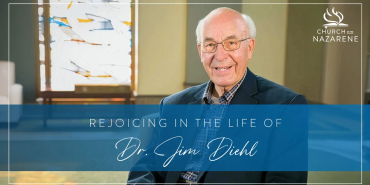First General Assembly Centennial, October 10

October 10 marks a century since the First General Assembly convened in Chicago at First Church of the Nazarene. The title page of the official proceedings state: "First General Assembly of the Pentecostal Church of the Nazarene" with the note underneath in small print: "Being the Twelfth Assembly of the Church of the Nazarene" and the "Twelfth Annual [Meeting] of the Association of Pentecostal Churches of America [APCA]." The assembly concluded on October 18.
The 1923 General Assembly chose the Second General Assembly at Pilot Point (1908) from which to mark the church's official anniversary. That was the terminus of a merger process, but the First General Assembly was its first concrete step. At Chicago, two holiness denominations with about 100 churches formed a new denomination stretching from Oxford, Nova Scotia, to San Diego, California. C. W. Ruth suggested this merger as a guest at the APCA Missionary Committee's June 1906 meeting. "Three wise men from the East" (A. B. Riggs, John Short, and H. N. Brown) responded by attending the Nazarene annual assembly in Los Angeles that autumn. In spring 1907, Phineas Bresee and others from the West met with eastern leaders in Brooklyn to plot out the dimensions of a merger. The First General Assembly was the happy outcome.
Highlights at Chicago
- Phineas Bresee (Los Angeles), general superintendent and the western church's guiding light since 1895, was elected first general superintendent of the united body. H. F. Reynolds (Brooklyn), the eastern group's general missionary secretary, was elected as his colleague. Other leading personalities at Chicago included C. W. Ruth (Indianapolis), H. D. Brown (Seattle), William Howard Hoople (Brooklyn), and Fred Hillery (Providence, Rhode Island).
- The basis of union was finalized, reconciling the connectional principle in the western church's Methodist-based system of organization with the congregational principle favored by easterners. The East agreed on district and general superintendents, while the West accepted the right of churches to call their pastors and for fully organized churches to be free from interference in their own affairs.
- C. B. Jernigan (Texas) headed a Southern delegation that participated in assembly discussions. Their positive report to the southern holiness churches paved the way for the next year's merger at Pilot Point, bringing the South into the united church and constituting the Pentecostal Church of the Nazarene on a truly national basis.
- The union included the workers and missions of two churches in India and Cape Verde.
Stan Ingersol is manager of the Nazarene archives at the International Headquarters of the Church of the Nazarene.
Holiness Today, September/October 2007
Please note: This article was originally published in 2007. All facts, figures, and titles were accurate to the best of our knowledge at that time but may have since changed.




